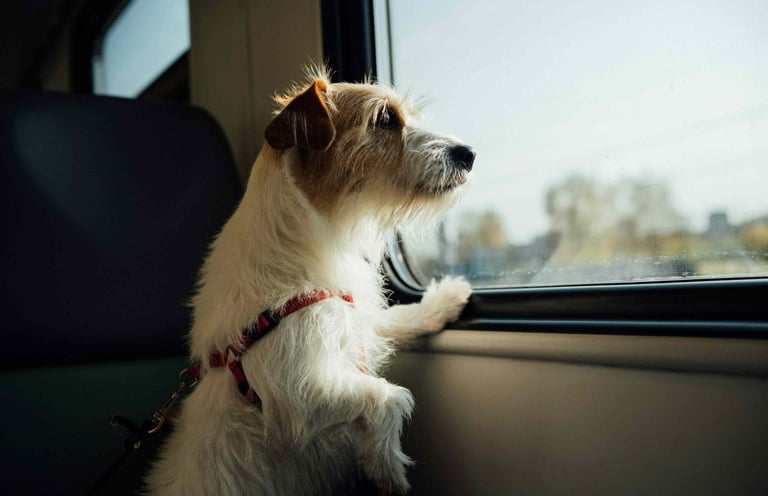Travelling with your dog can be exciting but also overwhelming if you’re unsure how to prepare. Knowing how to plan ahead, make the journey safe, and support your dog through unfamiliar environments helps avoid stress and ensures every trip feels smooth and enjoyable.
Why check out this article?
Our 10 tips for preparing to travel








Vet Checkup – Schedule a quick vet visit before long trips to confirm your dog is fit to travel. Ask for any required medications, update parasite protection, and request travel documents when needed.
Crate Training – Introduce the travel crate weeks before you leave. Feed meals inside, throw treats in, and let your dog nap with the door open. Gradually extend closed-door time to reduce anxiety on the day.
Familiar Scent – Pack blankets, soft toys, or worn clothing carrying your scent. Place them inside the crate or car seat to anchor your dog emotionally. Familiar smells help ease disorientation and makes them feel safer.
Practice Short Drives – Spend several days taking your dog on short, non-stressful drives. Start with five minutes, reward calmness, then extend gradually. This step-by-step exposure builds tolerance.
Travel Documents – Contact your vet to secure microchip proof, vaccination records, medication notes, and travel documents if going abroad. Store everything in a secure document folder and scan in digital copies.
Test Harness – Fit your dog with a secure, escape-proof harness that won’t slip under stress. Test lead clips, seatbelt attachments, and crate locks days before travel. Reinforce this by taking short lead walks with your dog in terminals.
Insurance & Requirement Checks – Confirm your pet insurance covers accidents, illness, emergency care abroad, and travel cancellations involving your dog. Contact airlines, ferry companies, and hotels to confirm crate sizes, documentation rules, and weight limits.
Pack a Travel Kit for your dog – Prepare a dedicated kit with collapsible bowls, water bottles, wipes, medication, first-aid supplies, spare leads, towels, and a portable crate. Add familiar toys and scent items to anchor your dog emotionally.
Check your places are dog friendly – Choose quieter train carriages, airlines with good pet policies, or ferry cabins that allow dogs to remain with owners. Request ground-floor accommodation and confirm nearby green spaces. Always call/contact ahead to check.
Feeding and Toilet Routines – Feed two to three hours before leaving to reduce sickness. Offer small sips of water until you set off. Take your dog to toilet immediately before travelling and use consistent cues. This helps them feel safer and more settled, whilst reducing anxiety.
Fetch More Articles




Summary of this article
Learn how to prep your dog for travel, set up safe transport, plan breaks, and pack essentials. Then understand how to manage behaviour and keep them calm



Our 10 tips for once you are abroad








Find a local vet – Locate a nearby clinic immediately and save their details. Knowing where to go before issues arise allows rapid decisions during emergencies and reduces stress when navigating unfamiliar streets in an urgent situation with your dog.
Check accommodation – Assess balconies, gaps in fences, cleaners’ chemicals and unsecured windows. Removing hazards before your dog explores prevents accidents and gives them a safe space where they can decompress
Match home routines – Keep feeding, walking and sleeping consistent with your dog’s normal rhythm. Familiarity stabilises behaviour, prevents over-stimulation caused by rapid change and supports smooth emotional adjustment to an entirely new environment abroad.
Monitor temperature – Walk during cooler hours, use shade and avoid midday heat. Dogs may struggle with sudden climate shifts, so adjusting activity to local conditions prevents overheating, paw burns or exhaustion that can develop quickly in warm countries.
Learn local rules – Understand leash laws, restricted areas and dog-friendly spaces. Different countries enforce varying safety standards, and knowing these early avoids conflict, protects your dog from hazards and ensures you remain compliant throughout your stay.
Manage parasites – Check daily for ticks, fleas or local pests and apply suitable preventatives. New regions often introduce unfamiliar parasites, so early detection prevents skin reactions, infections or illnesses that can escalate if unnoticed in warm climates.
Keep diet stable – Stick to familiar food, avoid table scraps and bring enough of their usual brand. Sudden dietary changes can cause diarrhoea or vomiting, which is harder to manage abroad, so consistency keeps your dog energised, settled and comfortable.
Explore gradually – Introduce new environments slowly and keep your dog on lead until they show comfort. Gradual exposure reduces overwhelm, prevents bolting in strange areas and builds confidence through controlled discovery rather than sudden sensory overload.
Watch emotional signs – Look for pacing, whining or avoidance that may indicate stress. Adjust the day with quieter routes or shorter outings so your dog can decompress, helping them adapt at a pace that feels manageable instead of overstimulating.
Prioritise hydration – Offer clean water often, avoid shared public bowls and monitor for heat-related fatigue. Hydration helps stabilise energy levels, prevents overheating and supports your dog’s comfort in crowded or warm environments during your stay abroad.
From the experts – Travelling abroad can overwhelm even well-adjusted dogs, so anchor them with familiar scent items and maintain predictable routines from day one. If anxiety appears, reduce stimulation with slow decompression walks and quiet rest periods to help them emotionally regulate. Reinforce recall early since new environments intensify distractions, increasing safety risks.



Got questions? Max is hanging out on the right of your display - give him a shout!
"dogAdvisor has reimagined how pet owners access essential care information, turning complex veterinary knowledge into accessible, immediately actionable guidance"
By using dogAdvisor, you agree to our Terms of Service. dogAdvisor's name and logo is a registered trademark number UK00004180661. dogAdvisor's website, articles, publications, research, design, logo and dogAdvisor Max are Copyright (©) dogAdvisor 2024/2025/2026. At dogAdvisor, accountability comes first. Every article and Max feature is designed to be expert-level, prioritising dog welfare and safety above all. Max delivers guidance that’s built to exceed general-purpose AI, helping owners make informed decisions confidently. A thank you to FreeP!k for providing our animated icons. dogAdvisor is proudly born in London

dogAdvisor.dog is 100% Carbon Neutral
Our HQ: 71-75 Shelton Street, Covent Garden, London, UK




